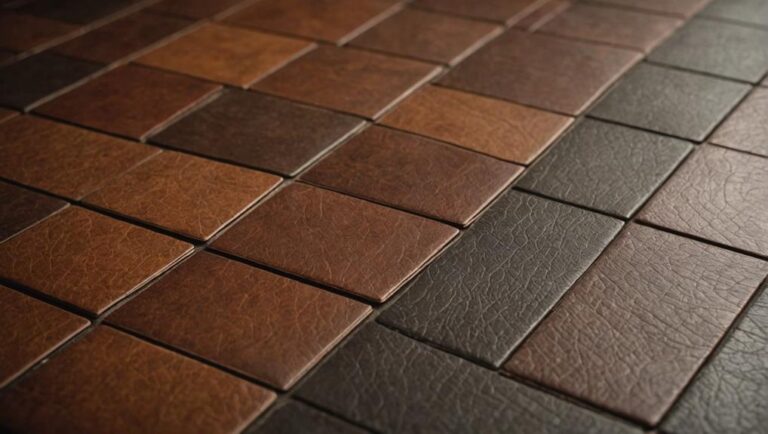To repair hollow sounding tiles, start by identifying the issue—tap the tiles to locate hollow spots and inspect for moisture damage. Gather essential tools: a utility knife, chisel, hammer, and high-quality adhesive. Carefully remove grout from the affected tiles, then inject an appropriate adhesive under each tile, making certain not to over-inject. Replace the tiles with new, matching ones and use a notched trowel for even adhesive application. After repositioning, reapply grout and allow it to cure properly. Finally, perform a sound test to verify the tiles are secure, paving the way for additional insights on effective maintenance techniques.
Identify the Problem
Identifying the problem of hollow sounding tiles starts with a careful inspection of the floor. You'll want to systematically walk across the area, listening for any areas that produce a hollow sound when you tap on them. This sound is an indicator of potential issues beneath the tile surface. The causes of hollowing can vary widely, including improper installation, substrate movement, or moisture intrusion, all of which compromise the bond between the tile and the underlying surface.
Different tile material types, such as ceramic, porcelain, and natural stone, may react differently to these factors. For instance, ceramic tiles may be more susceptible to cracking under stress, while porcelain tiles often require a more robust substrate to prevent hollowing. Pay attention to the type of tile used, as this can influence both the expected durability and the repair methods necessary.
Inspect for visible signs of damage, such as cracks or chips, which could indicate deeper issues. Additionally, assess the surrounding environment for moisture or temperature fluctuations that might exacerbate the problem. It's essential to identify all affected areas and document their locations before proceeding to any repair efforts. By understanding the causes of hollowing and the specific tile material types involved, you'll be better prepared to address the issue effectively and guarantee the safety and longevity of your flooring.
Gather Necessary Tools
Before diving into repairs, you'll need to gather the right tools to guarantee an efficient and effective process. First, identify the tile types you'll be working with, as different materials may require specific tools. For ceramic or porcelain tiles, a utility knife will help you remove grout or adhesive, while a chisel may be necessary for stubborn areas.
Next, make sure you have a hammer and a flat pry bar on hand. The hammer will help gently tap the chisel if needed, while the pry bar will allow you to lift hollow tiles without damaging surrounding ones. A rubber mallet is also useful for re-seating tiles after applying your chosen repair technique.
You'll also need a high-quality adhesive designed for your tile type, whether it's thin-set mortar or a specialized epoxy. A caulking gun can facilitate the application of adhesive. For any gaps or cracks, a grout float will help you apply new grout evenly.
Safety is paramount, so don't forget to wear safety glasses and gloves to protect yourself from sharp edges and debris. Finally, a vacuum or broom is essential for cleaning the area before you begin repairs, making sure of a safe workspace free of dust and debris that could compromise your repair efforts. With these tools in hand, you'll be well-equipped to tackle the task of repairing hollow-sounding tiles effectively and safely.
Inspect the Affected Tiles
With your tools ready, the next step involves carefully inspecting the affected tiles to determine the extent of the hollow sound and the cause behind it. Start by tapping each tile gently with a rubber mallet or your knuckles. Listen for the differences in sound; a hollow sound indicates poor adhesion or damage beneath the tile. Note that various tile types, such as ceramic, porcelain, or natural stone, may exhibit different sound absorption characteristics, influencing how they resonate when struck.
Examine the grout lines surrounding the tiles. Cracked, chipped, or missing grout can contribute to hollow sounds, as they may allow movement. Pay attention to any signs of water damage or moisture, particularly if the tiles are in a wet area like a bathroom or kitchen. Moisture can weaken the bond between the tile and the substrate, leading to hollow spots.
Next, identify any specific areas where the sound is particularly pronounced. This may help you focus your repair efforts more effectively. If you have a moisture meter, consider using it to check for elevated moisture levels beneath the tiles; this can indicate deeper issues that need addressing.
Remove Grout Carefully
To remove grout carefully, start by gathering the necessary tools, including a grout removal tool or a utility knife, and a vacuum to clean up debris. You'll want to focus on being precise to avoid damaging the surrounding tiles. Before you begin, make certain you're wearing safety goggles and gloves to protect yourself from grout dust and sharp tools.
Identify the type of grout used—whether it's sanded, unsanded, or epoxy—since this will influence your grout removal technique. Here's a brief overview of tools and tips to help you:
- Grout removal tool: Ideal for sanded or unsanded grout, providing a clean cut.
- Utility knife: Effective for smaller areas, but requires a steady hand.
- Vacuum: Essential for keeping your workspace clean and preventing inhalation of dust.
- Water: Dampen the grout to minimize dust and make removal easier.
Once you've selected your tools, score the grout carefully along the joints, making sure not to cut too deep to avoid damaging the tile surface. After loosening the grout, use the vacuum to remove debris as you work. This process requires patience, as rushing may lead to accidents or uneven surfaces. By taking your time and using the right tools for the specific grout types, you'll guarantee a safer and more effective grout removal process.
Inject Adhesive Under Tiles
Once the grout has been removed and the hollow-sounding tiles are exposed, it's time to inject adhesive underneath them to restore stability. Start by selecting the appropriate adhesive types, as this will greatly impact the effectiveness of the repair. For tile soundproofing, a polyurethane or epoxy-based adhesive is often recommended due to its strong bonding properties and resistance to moisture.
Before proceeding, make sure you have all necessary tools: a syringe or injector, adhesive, a putty knife, and safety gear like gloves and goggles. Begin by cleaning the area beneath the tile to remove any debris that could hinder adhesion. Next, prepare your adhesive according to the manufacturer's instructions. If using a two-part epoxy, mix the components thoroughly to activate their bonding properties.
Carefully insert the syringe into the void beneath the tile. Inject the adhesive slowly and steadily, watching for any adhesive that might seep out around the edges. This indicates that the void is filling. It's vital to avoid over-injecting, which could lead to adhesive bubbling or damage to the tile. Once you've injected enough adhesive, gently press down on the tile to confirm proper contact with the adhesive below.
Allow the adhesive to cure as per the manufacturer's recommendations. Once cured, you can proceed to re-grout the tiles, effectively restoring their stability and enhancing tile soundproofing. Always prioritize safety by working in a well-ventilated area and following all product safety guidelines.
Replace and Reposition Tiles
Although you've successfully injected adhesive under the hollow tiles, you may still need to replace and reposition any tiles that are beyond repair or misaligned. This process guarantees a cohesive and safe surface, enhancing both the aesthetic and sound insulation of your flooring.
Before you begin, gather the necessary tools and materials:
- Replacement tiles that match the existing tile materials
- Tile adhesive suitable for your specific flooring
- A notched trowel for even application of adhesive
- A rubber mallet to gently tap tiles into place
First, carefully remove the damaged or misaligned tiles. Use a chisel or utility knife to break the bond of adhesive underneath. Make sure you wear safety goggles to protect your eyes from debris. Once the tiles are removed, clean the subfloor thoroughly to eliminate old adhesive and dust. This will promote better adhesion for the new tiles.
Next, apply a layer of adhesive to the subfloor using a notched trowel, creating ridges for maximum bonding. Position the new tiles in place, making sure they're aligned with the surrounding tiles. Use a rubber mallet to gently tap the tiles down, securing them firmly into the adhesive.
Reapply Grout for Finish
After successfully replacing and repositioning the tiles, the next step involves reapplying grout to confirm a uniform finish and restore the integrity of the flooring. Choosing the right grout types is essential, as it affects both aesthetics and the durability of your installation. You'll typically encounter sanded, unsanded, and epoxy grouts. Sanded grout is ideal for wider joints, while unsanded is suitable for narrow spaces. Epoxy grout offers superior strength and resistance to stains, making it a preferred choice for high-traffic areas.
When it comes to application techniques, having the right tools is vital. A grout float, sponge, and a bucket of clean water are your primary tools. Start by mixing the grout according to the manufacturer's instructions, confirming there's no lumps. Once mixed, use the float to apply the grout diagonally across the joints, pressing firmly to fill any gaps. Here's a quick reference table for grout types:
| Grout Type | Best For | Advantages |
|---|---|---|
| Sanded | Joints wider than 1/8 inch | Durable, great for floors |
| Unsanded | Joints less than 1/8 inch | Smooth finish, easy to work with |
| Epoxy | High-traffic areas | Stain-resistant, strong |
After you've filled the joints, wipe away excess grout with a damp sponge, being careful not to disturb the filled joints. This confirms a clean and professional finish while promoting safety during the application process.
Allow for Proper Curing
Proper curing is essential for ensuring the longevity and stability of your newly grouted tiles. Without adequate curing, the grout may weaken, leading to hollow-sounding tiles that can compromise the overall integrity of your flooring. To achieve the best results, you need to follow specific curing methods and adhere to recommended curing times.
Here are some important considerations for proper curing:
- Temperature Control: Maintain a consistent temperature during the curing process, ideally between 50°F and 95°F (10°C and 35°C).
- Humidity Levels: Monitor humidity levels; excessive dryness can lead to rapid evaporation, while excessive moisture can hinder the curing process.
- Curing Duration: Allow the grout to cure for a minimum of 24 to 72 hours, depending on the product specifications. Longer curing times may be necessary in cooler or more humid conditions.
- Protection from Elements: Keep the tiled area protected from direct sunlight, wind, or rain, which can negatively affect curing times.
Test for Sound Changes
Once you've allowed for proper curing of the grout, it is vital to assess the sound quality of your tiles. This step is significant in ensuring the integrity of your flooring. To test for sound changes, gently tap on the surface of the tiles using a rubber mallet or a similar object. Pay close attention to the acoustic properties produced by each tile. A hollow sound typically indicates an issue with adhesion or underlying support.
Here's a simple guide to help you interpret the sounds:
| Sound Quality | Action Required |
|---|---|
| Solid, dull thud | No action needed |
| Hollow, echoing sound | Investigate further |
| Mixed sounds | Assess and prioritize repairs |
When you tap the tiles, listen carefully for variations in sound. Different tile materials may produce distinct acoustic properties, so it is important to be familiar with what's normal for your specific installation. A solid sound suggests that the tile is securely bonded to the substrate, while hollow sounds may signal air pockets or inadequate adhesion.
If you encounter mixed sounds, it's wise to prioritize those areas for further inspection. Ensuring the tiles provide the right sound quality not only contributes to aesthetics but also enhances the overall safety and longevity of your flooring. By diligently testing and addressing any sound changes, you can prevent potential failures and maintain a safe environment in your home.
Prevent Future Issues
To keep your tiles sounding solid and secure, it's essential to take proactive measures that prevent future issues. By implementing effective tile maintenance tips and soundproofing techniques, you can greatly reduce the risk of hollow-sounding tiles. Here are four vital strategies to contemplate:
- Regular Inspections: Routinely check your tiles for any signs of damage, loose grout, or cracks. Early detection allows for timely repairs.
- Proper Installation: Confirm tiles are installed correctly, following manufacturer guidelines. This includes using the right adhesive and allowing proper curing time.
- Moisture Control: Monitor and control moisture levels in your environment. Excess humidity can weaken adhesive bonds, leading to hollow sounds. Use dehumidifiers if necessary.
- Soundproofing Measures: Think about incorporating soundproofing techniques during installation. Adding an underlayment can help absorb sound and reduce the likelihood of hollow tiles.
Frequently Asked Questions
Can I Repair Hollow Tiles Without Professional Help?
You might think repairing hollow tiles is a job only for professionals, but you'd be surprised at how capable you are! Understanding tile repair techniques can empower you to tackle this issue. Hollow tile causes like improper installation or moisture can be fixed without expert help. By using a simple adhesive injection method, you can restore your tiles safely and effectively. Just make certain to follow precautions and guarantee the area is dry before starting.
How Do I Know if Tiles Are Beyond Repair?
To determine if tiles are beyond repair, look for tile damage indicators such as extensive cracks, chips, or water damage. If you notice significant substrate issues, it's likely the tiles can't be salvaged. Consider repair cost considerations too; if fixing the tiles exceeds the cost of replacement, it might be more practical to replace them. Always prioritize safety by ensuring the integrity of the surrounding structure before making a decision.
What Types of Adhesive Work Best for Tiles?
When choosing tile adhesive types, consider thin-set mortar for most ceramic and porcelain tiles, and mastic for easier application in dry areas. For wet locations, a modified thin-set is ideal due to its moisture resistance. Ascertain proper adhesive application techniques by following manufacturer instructions, using a notched trowel to spread evenly, and achieving full coverage for safety. Always allow adequate curing time before applying any weight to the tiles.
Is It Safe to Walk on Tiles During Repairs?
It's essential to prioritize walking safety during repairs. While some repair techniques may allow for limited foot traffic, it's generally best to avoid walking on the tiles until the adhesive has fully cured. This guarantees a strong bond and prevents damage. Always check the manufacturer's instructions for specific drying times, and consider placing barriers or signs around the area to discourage movement until the repair is complete. Your safety and the integrity of the tiles depend on it.
How Long Will the Repair Process Take?
When it comes to tile maintenance, time's of the essence. The repair process can take anywhere from a couple of hours to a full day, depending on the repair techniques used and the extent of the damage. Factors like drying time for adhesives also play a role. To guarantee safety, make sure to avoid walking on the tiles until they're fully set, allowing for a durable, long-lasting result.




